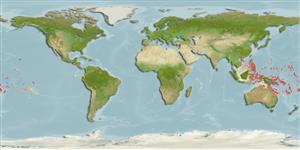Classification / Names
Common names from other countries
Main reference
Size / Weight / Age
Max length : 10.8 cm TL male/unsexed; (Ref. 11344)
Environment
Marine; reef-associated; depth range 0 - 30 m (Ref. 1602)
Climate / Range
Tropical, preferred ?; 20°N - 25°S
Distribution
Western Pacific: Philippines and Indonesia to Kiribati and Fiji, south to Rowley Shoals in the eastern Indian Ocean and the Great Barrier Reef. Reported from the Ryukyu Islands (Ref. 559).
Countries | FAO areas | Ecosystems | Occurrences | Introductions
Short description
Dorsal
spines
(total): 7;
Dorsal
soft rays
(total): 10-11;
Anal
spines: 1;
Anal
soft rays: 9 - 10;
Vertebrae: 26. Upper pectoral fin rays entire. Predorsal with 7-9 cycloid scales; trunk with ctenoid scales. Segmented and non branching caudal rays 4, branching 13. Body color yellowish white; 2 brown diagonal lines from preoperculum to upper jaw, connected by a single line; 2 almost vertical brown lines on operculum. 4th spine of 1st dorsal fin longest. No sharp distinction between sexes in pigmentation and elongation of 2nd dorsal, pelvic and anal fins. Males sometimes with 3-4 dusky vertical bars on abdomen (Ref. 420); fully united pelvic fins with well-developed frenum; longitudinal scale series 29-32; predorsal scales 7-9, reaching interorbital space; absence of scales on cheek or opercle; depth of body 4.7-6.1 in SL (Ref. 90102).
IUCN Red List Status (Ref. 115185)
Threat to humans
Harmless
Human uses
More information
ReferencesAquacultureAquaculture profileStrainsGeneticsAllele frequenciesHeritabilityDiseasesProcessingMass conversion
Tools
Special reports
Download XML
Internet sources
Estimates of some properties based on models
Phylogenetic diversity index
PD50 = 0.5010 many relatives (e.g. carps) 0.5 - 2.0 few relatives (e.g. lungfishes)
Trophic Level
3.4 ±0.3 se; Based on size and trophs of closest relatives
Resilience
High, minimum population doubling time less than 15 months (Preliminary K or Fecundity.)
Vulnerability
Low vulnerability (23 of 100)
Price category
